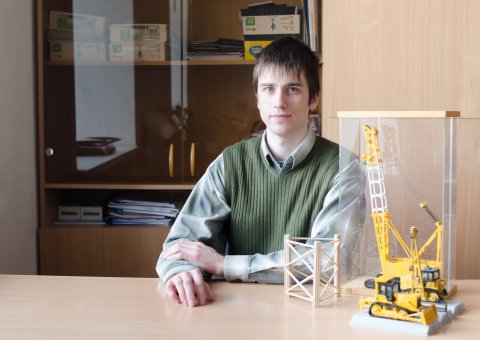The Day of Russian Science is to be celebrated at South Ural State University on February 8. This holiday gives an excellent opportunity to learn about the university’s achievements in various scientific spheres, including the sphere of construction. Modern construction is not just unique technologies and innovative materials, but also the highest safety requirements. Modern inventions allow taking into account any loads and impacts while designing various industrial of civil structures. Scientists of South Ural State University are developing a program with the use of efficient calculation methods for designing reliable buildings, resistant to exposure to various loads.
Solving complex problems in structural mechanics
Project of Nikita Zyambaev, a postgraduate student of the Department of Construction Operations and Theory of Structures of the SUSU’s Institute of Architecture and Construction, is dedicated to time impact analysis of a carcass building on impulse exposures. The method of time impact analysis developed by scientific supervisor Aleksandr Potapov, Doctor of Engineering Sciences and Professor – is a discovery in solution of dynamic problems of structural mechanics.
“Research of operation of materials in building structures under conditions of dynamic loads (for example, impacts, impulses, vibration loads) at the present time is mainly conducted by numerical methods. Meanwhile the method developed by us allows recording characteristics of a dynamic model and various parameters of a structure’s reaction (such as motions, acceleration velocities, restoring forces and other dynamic parameters in structural connections) in the analytical form,” says the young scientist.
The research of Nikita Zyambaev was noted as one of the most practically significant at the contest of young scientists’ works called “Scientific Potential”, which was held by SUSU within the frameworks of Project 5-100.

Construction in seismically hazardous areas
Special attention while designing structures should be paid to methods of calculation of building structures subject to impulse, including seismic, loads. In such cases, structures are exposed to not only ordinary loads, but also to impulse loads which occur during earthquakes. These loads are of cyclic character and can act in various directions.
“We apply direct integration of equation of our dynamic model’s motion in real time. This allows obtaining kinematic and strength parameters of structural connections with a certain time step. The less is the step, the higher is measurement accuracy,” explains Nikita Zyambaev.
The developed calculation method allows conducting extensive and multi-parameter analysis of a structure’s operation during the entire stage of analysis, which is especially relevant while designing buildings and structures subject to unpredictable exposures such as impacts, earthquakes, etc.
Time impact analysis is a new and efficient method
The nowadays popular numerical methods do not allow recording solution in the analytical form or, correspondingly, conducting a full dynamic analysis at the entire interval of a structure’s operation.
“In our work we apply the method of time analysis, with the use of which dynamic reaction is recorded as a Duhamel’s integral. This method gives the possibility to analytically determine all parameters of structural reaction (kinematic parameters: motions, velocities and accelerations of carcass connections; strength parameters: restoring and inertial forces and friction forces in connections). Besides, it allows taking into account the multi-cycle nature of carcass deforming,” says the SUSU postgraduate student.
At the moment, programs for time impact analysis of a one-storeyed carcass and a program for calculating a multi-storeyed flat carcass whose studs’ material is working by bilinear diagram of deformation have been developed. Such programs will be in demand among organizations which provide services in design or dynamic calculations of building structures.
“Algorithm for calculating building structures, which is planned to be developed during the project, will not only allow conducting a full dynamic analysis of a simulation model, but also will be able to be used while estimating accuracy of approximate solutions obtained by numerical methods,” says Nikita Zyambaev.
In a result scientists of South Ural State university are planning to create a narrow-specialized program which will be intended for calculation of plane frames and carcasses for impulse loads, and estimation of a structure’s operation during exposures to loads beyond design basis. Such program will be relevant for specialists in the sphere of construction as it will be more accurate and cheaper that its universal analogs.




